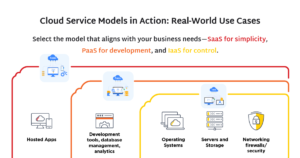SaaS vs PaaS vs IaaS: What’s Best for Your Business?
While digital transformation is rapidly adopted by firms, one of the key enablers of this growth is cloud computing. It matters a lot whether you aim to launch a contemporary application or simplify the processes on a day-to-day basis, which cloud service model to apply. Cloud services are classified into three broad classes: Software as a Service (SaaS), Platform as a Service (PaaS) and Infrastructure as a Service (IaaS). Each gives various degree of control, customization, and assistance, thus responding to varying organizational requirements. In this blog, we will review the features of these models, trusting that you will be able to select the one that is the most appropriate for your corporation.

What is Software as a Service (SaaS)?
SaaS is a kind of cloud service that delivers complete, operational software products via the web. The backs that have a lot of these services do not worry about the biological makeup of the company in terms of its repairs or upgrades for as all these are taken care of by the client that has established the accounts. There is no need to install the software on any computer, as internet access is sufficient to run the software.
The advantages of SaaS cover a wide range
- User-friendliness: Very quick to deploy without any hardware or software installation.
- Scalability: Adding or deleting users is simple and based on usage requirements.
- Affordable: Costs are related to subscriptions hence no need for huge initial costs.
Examples of popular SaaS platforms
- Google Workspace for office productivity.
- Salesforce for customer relationship management (CRM).
- Zoom for meetings.
Best located at: The small, medium and large enterprises which require turn-key software at the time of provision with little modifications. SaaS was designed specifically for users without a technical background or companies that do not have well functional IT departments.
What is PaaS (Platform as a Service)?
PaaS is a cloud-based platform that allows software developers to develop, deploy, and maintain applications without the burden of dealing with the development and maintenance of the entire hardware system. It encompasses development frameworks, runtime environments, middleware, and database management systems that are owned and operated by the vendor. While using the platform, all that developers have to do, is write the logic of the application.
Key benefits of PaaS include
- Faster development: Streamlines coding, testing, and deploying applications.
- Built-in tools: Access to frameworks, databases, and APIs.
- Reduced complexity: No need to manage servers, storage, or networking.
Examples of popular PaaS platforms
- Microsoft Azure for building cloud-based applications.
- Google App Engine for scalable web and mobile applications.
- Heroku for deploying and scaling applications with ease.
Best suited for: Startups, developers, and businesses looking to build custom applications without the hassle of managing hardware or infrastructure.
What is IaaS (Infrastructure as a Service)?
IaaS offers the most control over cloud resources by providing virtualized computing infrastructure, such as servers, storage, and networking. Unlike SaaS and PaaS, IaaS allows businesses to manage and configure their own systems, offering the flexibility to create custom IT environments.
Key benefits of IaaS include
- Complete control: Configure and manage your virtual infrastructure.
- Scalability: Easily scale up or down depending on demand.
- Flexibility: Tailor your infrastructure to meet specific business needs.
Examples of popular IaaS platforms
- Amazon Web Services (AWS) for a wide range of cloud services.
- Microsoft Azure for customizable infrastructure solutions.
- Google Cloud Platform (GCP) for scalable compute and storage options. ( Learn More Anout Google Cloud )
Best suited for: Large enterprises or businesses with specific infrastructure requirements and in-house IT teams that need full control over their computing environment.
Key Differences Between SaaS, PaaS, and IaaS
| Feature | SaaS | PaaS | IaaS |
| Control | Minimal control over the software | Control over apps and development tools | Full control over infrastructure |
| Customization | Limited customization | Custom apps, limited infrastructure | Full customization |
| Maintenance | Managed by provider | Managed infrastructure, user handles apps | Full responsibility for maintenance |
| Cost | Subscription-based, lower upfront costs | Typically subscription-based | Pay-as-you-go, cost scales with usage |
| Best for | End-users, non-technical teams | Developers, small to medium businesses | Enterprises, IT teams, large businesses |
Factors to Consider When Choosing Between SaaS vs PaaS vs IaaS
- Choosing the right cloud version depends on various factors
- Business desires: If you require ready-to-use software program, SaaS is the high-quality option. For application development, PaaS works nicely, even as IaaS is good for companies desiring custom infrastructure.
- Budget: SaaS gives a predictable subscription version, even as IaaS costs primarily based on aid usage, which could range extensively.
- Technical expertise: SaaS calls for little technical know-how, while PaaS and IaaS demand extra technical skills, specifically IaaS, which calls for infrastructure control.
- Scalability: All fashions offer scalability, but IaaS affords the most flexibility for scaling resources as commercial enterprise wishes evolve.
- Security and compliance: If your business handles sensitive statistics or wishes strict compliance, IaaS gives the highest degree of manage over safety protocols.
Case Studies or Use Cases
- SaaS Example: A small e-commerce business uses Shopify, a SaaS platform, to manage its online store without needing to handle website hosting or software updates.
- PaaS Example: A startup developing a mobile app chooses Google App Engine to quickly deploy and scale their app, without managing infrastructure.
- IaaS Example: A financial services company uses AWS to set up custom infrastructure that meets their specific security and compliance requirements while allowing them to scale as needed.
Which Model is Best for Your Business?
Each of the three cloud service models SaaS, PaaS, and IaaS is advantageous in its way and caters to a different type of business requirement. If your business demands immediate software that requires little customization, go with SaaS. If you are a developer who would wish to develop applications on existing architecture, then PaaS is the right solution. Those that want to manage everything including the infrastructure while customizing resources should look out for IaaS.
However, before you proceed to make any decision, look at your business’s technical requirements, budget allocation, and goal achievement time frames. The correct decision can help a great deal in enhancing productivity and making your processes more efficient.




